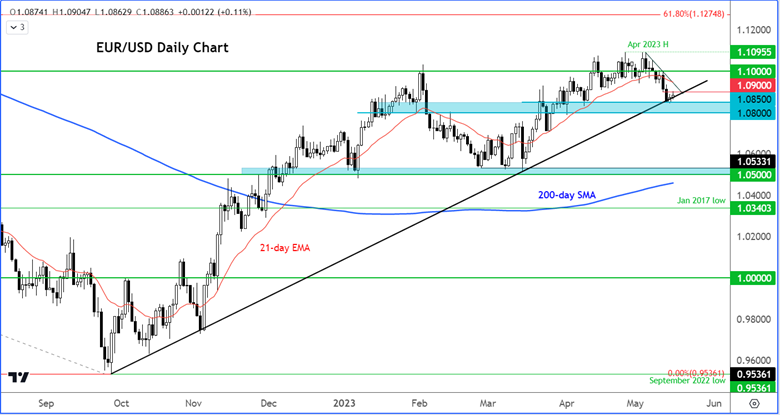The key short-term risk facing the EUR/USD outlook and many other FX pairs is the potential for a default by US Treasury, which could send risk assets plunging across the board, states Fawad Razaqzada of Trading Candles.
This also implies that in the event of a likely resolution in the US debt-ceiling talks, i.e., kicking the can further down the road, risk assets should be able to sigh relief. That’s precisely what the market is betting on right now—that the two sides will strike a compromise. For, had it been otherwise, there is no chance the markets would be THIS stable.
Indeed, the EUR/USD has managed to hold its own relatively well at the start of this week, finding mild support around the 1.0850 area. The apparent strength seems even more remarkable given the renewed weakness we have observed in Eurozone (and Chinese) data, while the hawkish Fed commentary continues unabated. But the calm could be due to many traders just sitting on their hands until there’s a breakthrough in the debt ceiling talks.
Regardless of the short-term direction of the US dollar, owing to the uncertainty caused by the debt ceiling talks, the slightly longer-term view remains bearish. Later in the year, we are likely to see signs of disinflation and a weaker economy, because of the cumulative impact of the past rate hikes and sustained periods of high inflation. The Fed might have to cut rates sooner than it currently envisages.
EUR/USD Shrugs of Weaker Eurozone and Chinese Data
We have seen some rather negative data emerge from the Eurozone and China, suggesting that the recovery from the start of the year is starting to fade, and consumers and business struggle with the cost-of-living crisis.
From the Eurozone, industrial production came in at -4.1% m/m compared to a smaller fall expected on Monday. There was more negative news out Tuesday as the German ZEW Economic Sentiment survey printed -10.7 vs. -5.4 expected. While Eurozone GDP was in line with the expectations at +0.1% q/q, not many people would have paid much attention to it anyway, even if it had surprised, for it is backward-looking. The latest data comes after a disappointing last week when we saw weaker-than-expected German industrial production (-3.4% m/m vs. -1.6% expected) and Sentix Investor Confidence (-13.1 vs. -8.0 eyed).
Regardless of the short-term direction of the US dollar, owing to the uncertainty caused by the debt ceiling talks, the slightly longer-term view remains bearish. Later in the year, we are likely to see signs of disinflation and a weaker US economy, because of the cumulative impact of the past rate hikes and sustained periods of high inflation. The Fed, therefore, might have to cut rates sooner than it currently envisages.
US Debt Ceiling Talks Set To Resume
The ongoing stalemate in the US debt ceiling talks is meant to be negative for risk-sensitive currency pairs, as too should be the disappointing economic data from China. Yet, the EUR/USD is holding its own above the long-term bullish trend line and key support around 1.0850 – at least for now anyway.
With the euro shrugging off bearish news, this is a sign of strength. The potential for a resolution in the US debt ceiling stalemate could fuel a rally in EUR/USD and other risk assets.
Talks on this matter are set to resume between Joe Biden, House Speaker Steve McCarthy, and several Congressional leaders later today.
US Retail Sales Disappoint
April retail sales, released earlier today, were expected to show a 0.8% m/m rise after falling 0.6% in March.
However, they came in softer, causing the dollar index to initially drop. On the headline front, sales were up 0.4% m/m, missing expectations of a 0.8% rise. On the core front, sales rose 0.4%, below expectations of 0.5%.
Weaker sales further diminish the already-minority view that the Fed could hike rates again in June – not that the Fed has stopped with its hawkish rhetoric. FOMC official Thomas Barkin has said he saw no barriers to hiking rates again in June.
However, we think that the Fed has reached a peak in terms of interest rates, so Barkin’s comments are likely to – as they have – fall on deaf ears.
Next up on the US economic calendar, we have some housing market data on Tuesday (NAHB Housing Market Index), Wednesday (Building Permits and Housing Starts) and Thursday (Existing Home Sales). This week’s other US macro data include Unemployment Claims and the Philly Fed Manufacturing Index, both on Thursday.
EUR/USD Technical Analysis
The EUR/USD printed a small bullish candle around the 1.0850 area on Monday despite negative news from the Eurozone. The rebound means the longer-term bullish trend line has been defended—at least for now, anyway.
Bullish traders need to see the breakdown of some key resistance levels here, starting with 1.0900, in order to support the short-term EUR/USD outlook.
Bearish speculators will want the EUR/USD to remain offered around key resistance levels, leading to a potential drop below 1.0850. A closing break below this level could pave the way for a deeper retracement towards 1.0700 or even lower.

Source: TradingView.com
To learn more about Fawad Razaqzada visit TradingCandles.com.





















